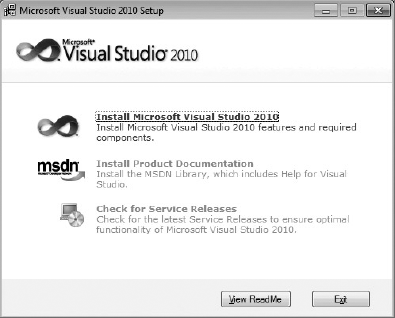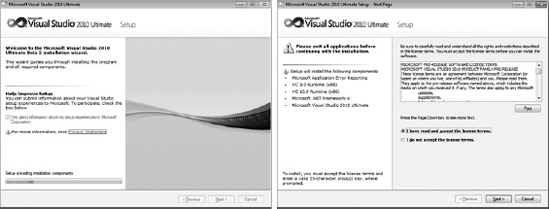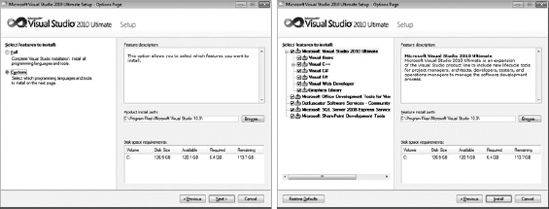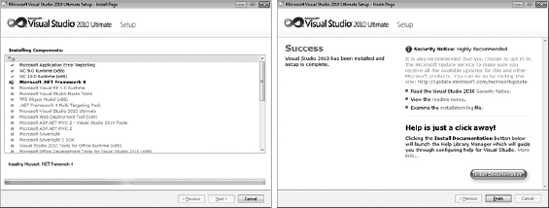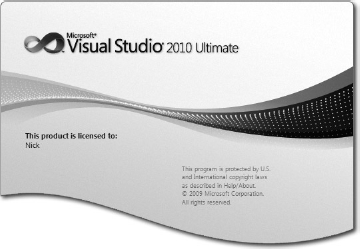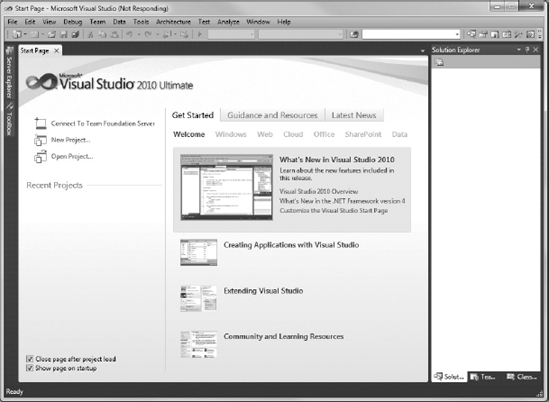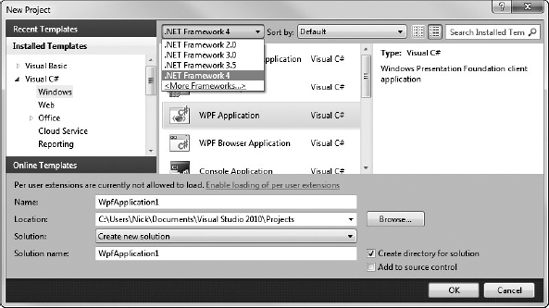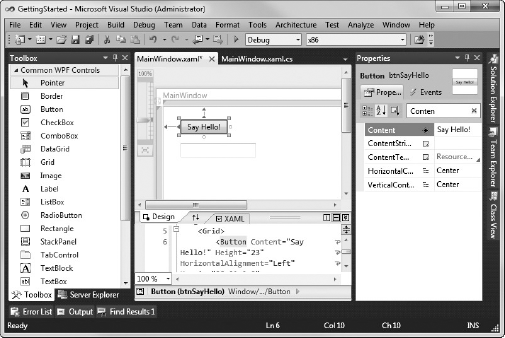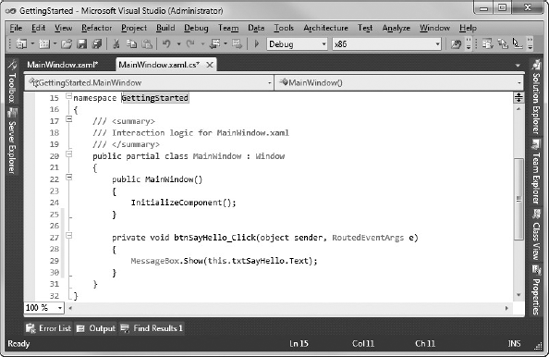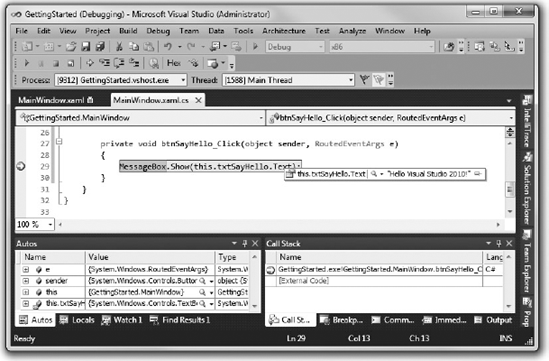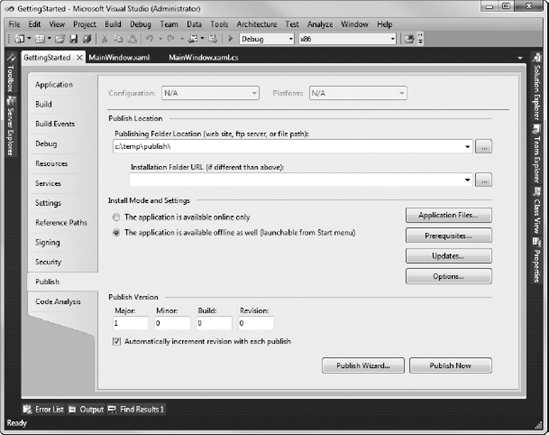Ever since we have been developing software, there has been a need for tools to help us write, compile, debug, and deploy our applications. Microsoft Visual Studio 2010 is the next iteration in the continual evolution of a best-of-breed integrated development environment (IDE).
This chapter introduces the Visual Studio 2010 user experience and shows you how to work with the various menus, toolbars, and windows. It serves as a quick tour of the IDE, and as such it doesn't go into detail about what settings can be changed or how to go about customizing the layout, because these topics are explored in the following chapters.
With each iteration of the Visual Studio product, the installation process has been incrementally improved, meaning that you can now get up and running with Visual Studio 2010 with minimal fuss. This section walks you through the installation process and getting started with the IDE.
When you launch Visual Studio 2010 setup, you see the dialog in Figure 1-1 showing you the three product installation stages. As you would imagine, the first stage is to install the product itself. The other two stages are optional. You can either install the product documentation locally, or use the online (and typically more up-to-date) version. It is recommended that you do search for service releases because it ensures you are working with the most recent version of the product and associated tools.
As you progress through the setup process you are prompted to provide feedback to Microsoft (left image, Figure 1-2) and agree to the licensing terms for the product (right image, Figure 1-2).
The Visual Studio 2010 setup process has been optimized for two general categories of developers: those writing managed, or .NET, applications, and those writing native, or C++, applications (left image, Figure 1-3). The Customize button allows you to select components from the full component tree as shown in the right image of Figure 1-3.
Once you have selected the components you want to install, you see the updated progress dialog in the left image of Figure 1-4. Depending on which components you already have installed on your computer, you may be prompted to restart your computer midway through the installation process. When all the components have been installed, you see the setup summary dialog in the right image of Figure 1-4. You should review this to ensure that no errors were encountered during installation.
When you launch Visual Studio the Microsoft Visual Studio 2010 splash screen appears. Like a lot of splash screens, it provides information about the version of the product and to whom it has been licensed, as shown in Figure 1-5.
Note
An interesting fact about the splash screen is that while a large portion of Visual Studio now uses WPF to display its content, the new splash screen in Visual Studio 2010 is still done in native code so that it displays as soon as possible after you start Visual Studio. A significant amount of time went into hand crafting the wave at the bottom of the splash screen, so make sure you marvel at it whenever you're sitting there patiently waiting for Visual Studio to load.
The first time you run Visual Studio 2010, you see the splash screen only for a short period before you are prompted to select the default environment settings. It may seem unusual to ask those who haven't used a product before how they imagine themselves using it. Because Microsoft has consolidated a number of languages and technologies into a single IDE, that IDE must account for the subtle (and sometimes not so subtle) differences in the way developers work.
If you take a moment to review the various options in this list, as shown in Figure 1-6, you'll find that the environment settings that are affected include the position and visibility of various windows, menus, and toolbars, and even keyboard shortcuts. For example, if you select the General Development Settings option as your default preference, this screen describes the changes that will be applied. Chapter 3 covers how you can change your default environment settings at a later stage.
Note
A tip for Visual Basic .NET developers coming from previous versions of Visual Studio is that they should not use the Visual Basic Development Settings option. This option has been configured for VB6 developers and will only infuriate Visual Basic .NET developers, because they will be used to different shortcut key mappings. We recommend that you use the general development settings, because these will use the standard keyboard mappings without being geared toward another development language.
Depending on which set of environment settings you select, when you click the Start Visual Studio button you will most likely see a dialog indicating that Visual Studio is configuring the development environment. When this process is complete, Visual Studio 2010 opens, ready for you to start work, as shown in Figure 1-7.
Regardless of the environment settings you selected, you see the Start Page in the center of the screen. However, the contents of the Start Page and the surrounding toolbars and tool windows can vary.
Note
If you click the grey rounded rectangle with the text "Download the latest information for developers to the Start Page," this pulls down news items from an RSS feed specified in the environment settings you specified. Each item is displayed in summary within the rectangle, allowing you to click through to the full article. You can customize this feed by changing the Start Page News Channel property on the Environment
Before you launch into building your first application, it's important to take a step back and look at the components that make up the Visual Studio 2010 IDE. Menus and toolbars are positioned along the top of the environment, and a selection of subwindows, or panes, appears on the left, right, and bottom of the main window area. In the center is the main editor space: whenever you open a code file, an XML document, a form, or some other file, it appears in this space for editing. With each file you open, a new tab is created so that you can toggle among opened files.
On either side of the editor space is a set of tool windows: these areas provide additional contextual information and functionality. In the case of the general developer settings, the default layout includes the Solution Explorer and Class View on the right, and the Server Explorer and Toolbox on the left. The tool windows on the left are in their collapsed, or unpinned, state. If you click a tool window's title, it expands; it collapses again when it no longer has focus or you move the cursor to another area of the screen. When a tool window is expanded, you see a series of three icons at the top right of the window, similar to those shown in the left image of Figure 1-8.
If you want the tool window to remain in its expanded, or pinned, state, you can click the middle icon, which looks like a pin. The pin rotates 90 degrees to indicate that the window is now pinned. Clicking the third icon, the X, closes the window. If later you want to reopen this or another tool window, you can select it from the View menu.
Note
Some tool windows are not accessible via the View menu; for example, those having to do with debugging, such as threads and watch windows. In most cases these windows are available via an alternative menu item; in the case of the debugging windows, it is the Debug menu.
The right image in Figure 1-8 shows the context menu that appears when the first icon, the down arrow, is clicked. Each item in this list represents a different way of arranging the tool window. As you would imagine, the Float option allows the tool window to be placed anywhere on the screen, independent of the main IDE window. This is useful if you have multiple screens, because you can move the various tool windows onto the additional screen, allowing the editor space to use the maximum screen real estate. Selecting the Dock as Tabbed Document option makes the tool window into an additional tab in the editor space. In Chapter 4, you learn how to effectively manage the workspace by docking and pinning tool windows.
Now that you have seen an overview of the Visual Studio 2010 IDE, this section walks through creating a simple application that demonstrates working with some of these components. This is, of course, the mandatory "Hello World" sample that every developer needs to know, and it can be done in either Visual Basic .NET or C#, depending on what you feel more comfortable with.
Start by selecting File

Select the WPF Application from the Templates area (this item exists under the root Visual Basic and Visual C# nodes, or under the sub-node Windows) and set the Name to GettingStarted, before selecting OK. This should create a new WPF application project, which includes a single startup window and is contained within a GettingStarted solution, as shown in the Solution Explorer window of Figure 1-10. This startup window has automatically opened in the visual designer, giving you a graphical representation of what the window will look like when you run the application. You will notice that the Properties tool window has appeared at the bottom of the right tool windows area.
Click the Toolbox tool window, which causes the window to expand, followed by the pin icon, which pins the tool window open. To add controls to the window, select the appropriate items from the Toolbox and drag them onto the form. Alternatively, you can double-click the item and Visual Studio automatically adds them to the window.
Add a button and textbox to the form so that the layout looks similar to the one shown in Figure 1-11. Select the textbox and select the Properties tool window (you can press F4 to automatically open the Properties tool window). Change the name of the control to
txtToSay. Repeat for the Button control, naming itbtnSayHelloand setting theContentproperty toSay Hello!You can quickly locate a property by typing its name into the search field located beneath the Name field. In Figure 1-11 "Conten" has been entered in order to reduce the list of Properties so that it's easier to locate the Content property.
You will also notice that after you add controls to the window, the tab is updated with an asterisk (*) after the text to indicate that there are unsaved changes to that particular item. If you attempt to close this item while changes are pending, you are asked if you want to save the changes. When you build the application, any unsaved files are automatically saved as part of the build process.
Note
One thing to be aware of is that some files, such as the solution file, are modified when you make changes within Visual Studio 2010 without your being given any indication that they have changed. If you try to exit the application or close the solution, you are still prompted to save these changes.
Deselect all controls and then double-click the button. This not only opens the code editor with the code-behind file for this form, it also creates and wires up an event handler for the click event on the button. Figure 1-12 shows the code window after a single line has been added to echo the message to the user.
Before you build and execute your application, place the cursor somewhere on the line containing
Messagebox.Showand press F9. This sets a breakpoint — when you run the application by pressing F5 and then click the "Say Hello!" button, the execution halts at this line. Figure 1-13 illustrates this breakpoint being reached. The data tip, which appears when the mouse hovers over the line, shows the contents of thetxtToSay.Textproperty.The layout of Visual Studio in Figure 1-13 is significantly different from the previous screenshots, because a number of new tool windows are visible in the lower half of the screen, and new command bars are visible at the top. When you stop the application you will notice that Visual Studio returns to the previous layout. Visual Studio 2010 maintains two separate layouts: design time and run time. Menus, toolbars, and various windows have default layouts for when you are editing a project, whereas a different setup is defined for when a project is being executed and debugged. You can modify each of these layouts to suit your own style and Visual Studio 2010 will remember them.
The last step is to deploy your application. Whether you're building a rich client application using Windows Forms or WPF, or a web application, Visual Studio 2010 has the ability to publish your application. Double-click the Properties node in Solution Explorer and select the Publish node to display the options for publishing your application, as shown in Figure 1-14.
In Figure 1-14, the publishing folder has been set to a local path, but you can specify a network folder, an IIS folder, or an FTP site instead. Once you have specified where you want to publish to, clicking Publish Now publishes your application to that location.
You've now seen how the various components of Visual Studio 2010 work together to build an application. The following list outlines the typical process of creating a solution:
Use the File menu to create a solution.
Use the Solution Explorer to locate the window that needs editing and double-click the item to show it in the main workspace area.
Drag the necessary components onto the window from the Toolbox.
Select the window and each component in turn, and edit the properties in the Properties window.
Double-click the window or a control to access the code behind the component's graphical interface.
Use the main workspace area to write code and design the graphical interface, switching between the two via the tabs at the top of the area.
Use the toolbars to start the program.
If errors occur, review them in the Error List and Output windows.
Save the project using either toolbar or menu commands, and exit Visual Studio 2010.
In subsequent chapters, you learn how to customize the IDE to more closely fit your own working style, and how Visual Studio 2010 takes a lot of the guesswork out of the application development process. You also see a number of best practices for working with Visual Studio 2010 that you can reuse as a developer.

